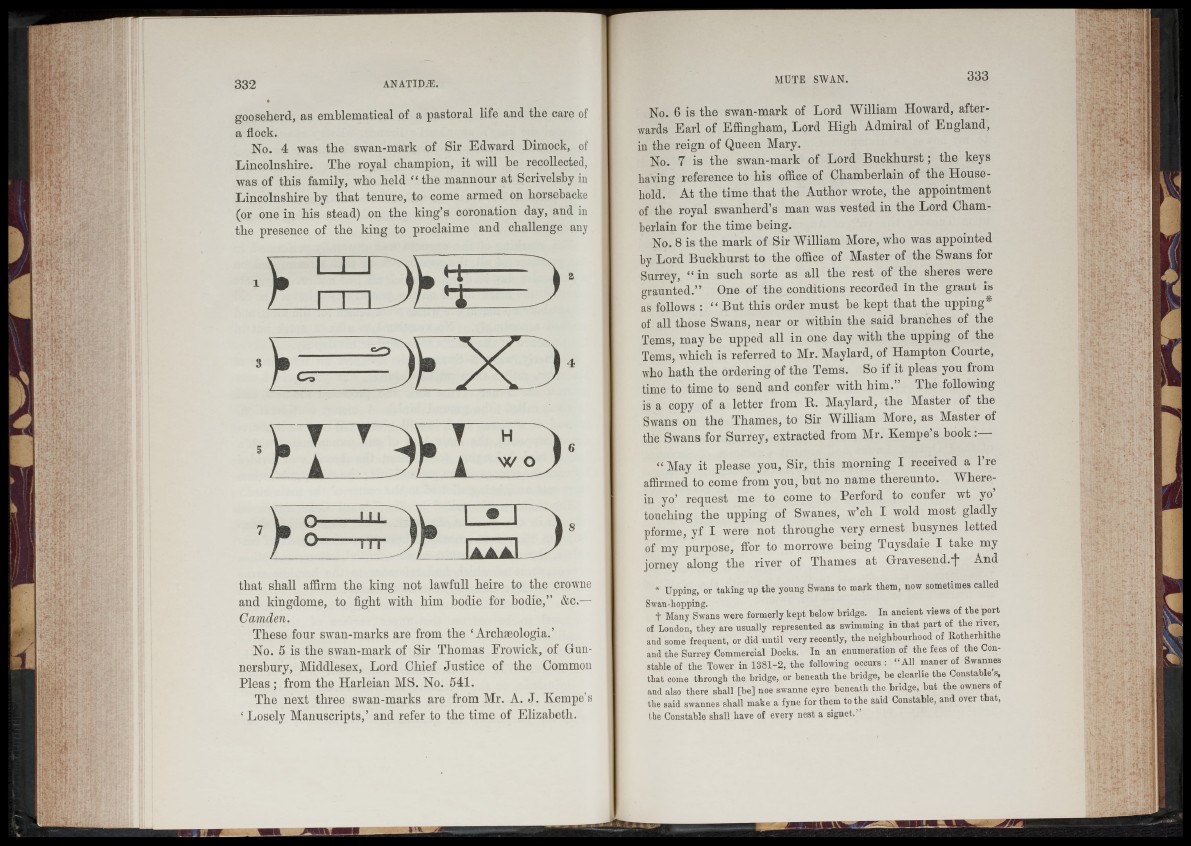
gooseherd, as emblematical of a pastoral life and the care of
a flock.
No. 4 was the swan-mark of Sir Edward Dimock, of
Lincolnshire. The royal champion, it will be recollected,
was of this family, who held “ the mannour at Scrivelsby in
Lincolnshire by that tenure, to come armed on horsebacke
(or one in his stead) on the king’s coronation day, and in
the presence of the king to proclaime and challenge any
that shall affirm the king not lawfull heire to the crowne
and kingdome, to fight with him bodie for bodie,” &c.—
Camden.
These four swan-marks are from the £ Archseologia.’
No. 5 is the swan-mark of Sir Thomas Fro wick, of Gun-
nersbury, Middlesex, Lord Chief Justice of the Common
Pleas; from the Harleian MS. No. 541.
The next three swan-marks are from Mr. A. J. Kempe’s
‘ Losely Manuscripts,’ and refer to the time of Elizabeth.
No. 6 is the swan-mark of Lord William Howard, afterwards
Earl of Effingham, Lord High Admiral of England,
in the reign of Queen Mary.
No. 7 is the swan-mark of Lord Buckhurst; the keys
having reference to his office of Chamberlain of the Household.
At the time that the Author wrote, the appointment
of the royal swanherd’s man was vested in the Lord Chamberlain
for the time being.
No. 8 is the mark of Sir William More, who was appointed
by Lord Buckhurst to the office of Master of the Swans for
Surrey, “ in such sorte as all the rest of the sheres were
graunted.” One of the conditions recorded in the grant is
as follows : “ But this order must be kept that the upping*
of all those Swans, near or within the said branches of the
Terns, may be upped all in one day with the upping of the
Terns, which is referred to Mr. Maylard, of Hampton Couite,
who hath the ordering of the Terns. So if it pleas you from
time to time to send and confer with him. The following
is a copy of a letter trom B. Maylard, the Mastei of the
Swans on the Thames, to Sir William More, as Master of
the Swans for Surrey, extracted from Mr. Kempe’s book:—
“ May it please you, Sir, this morning I received a l’re
affirmed to come from you, but no name thereunto. Wherein
yo’ request me to come to Perford to confer wt yo’
touching the upping of Swanes, w’ch I wold most gladly
pforme, yf I were not tliroughe very ernest busynes letted
of my purpose, ffor to morrowe being Tuysdaie I take my
jorney along the river of Thames at Gravesend."J* And
* Upping, or ta k in g u p th e young Swans to m a rk th em , now sometimes called
Swan-hopping. . .
f Many Swans were formerly k e p t below bridge. In an c ien t views ot th e p o rt
of London, th e y are usually rep re se n ted as swimming in th a t p a r t of th e riv er,
and some freq u en t, or did u n til v ery recently, th e neighbourhood of R o th e rh ith e
and th e S u rrey Commercial Docks. In an enum eration of th e fees of th e Constable
of th e Tower in 1 3 8 1 -2 , th e following occurs : “ All m an er of Swannes
th a t come through th e bridge, or b en e ath th e bridge, be clearlie th e Constable s,
and also th e re shall [be] noe swanne eyre b en e a th th e bridge, b u t th e owners of
the said swannes sh a ll make a fyne for th em to th e said Constable, an d over th a t,
the Constable sh a ll have of every n est a signet.